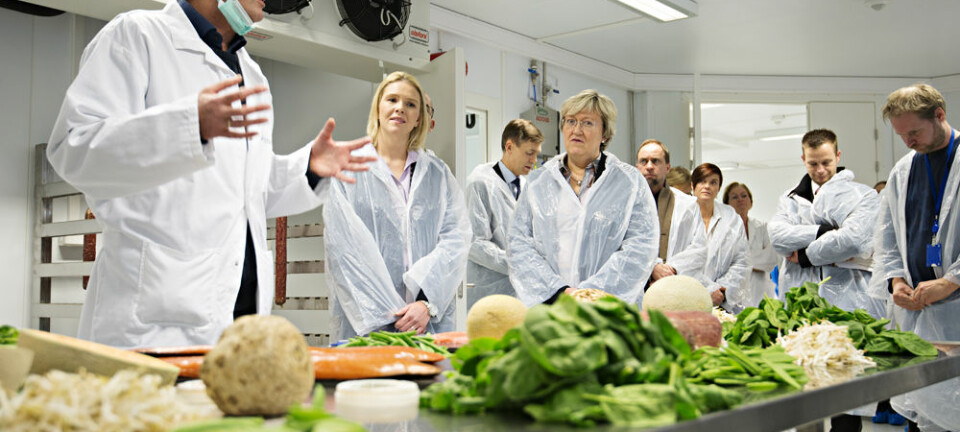
Endocrine disrupters in food and clothing replaced by equally dangerous chemicals
Scientists warn that the "safe" alternatives to endocrine disrupters in foods and clothing can be just as harmful and even lead to miscarriages.
Fluorinated substances are found everywhere in our daily environment, from the food we eat to the material it is packaged in. These widely used chemicals are popular with the food industry but they also accumulate in our bodies over time.
Last week, it was revealed that some of the commonly used fluorinated substances are associated with an increased risk of a miscarriage.
It comes after a number of studies have in recent years suggested that fluorinated substances - such as PFOA and other compounds found in Teflon and parchment paper - can be harmful. Therefore, the “old” fluorinated substances have mostly been replaced by new ones. But a new declaration, signed by more than 200 researchers, warns that the new alternatives can be just as damaging as those old fluorinated compounds.
"The problem is that when sufficient research has shown that a particular substance is harmful, we replace it with another fluorinated substance. But the new substances may prove to be just as harmful as the old – or perhaps even worse," says chemist Xenia Trier, a researcher in fluorinated substances with the National Food Institute, at the Danish Technical University in Copenhagen.
She is one of the researchers behind the The Madrid Statement, which calls on politicians and industry to put an end to the widespread use of fluorinated substances.
Fluorinated substances increase risk of miscarriage
Danish politicians have also been discussing these fluorinated substances, after a new study from the University of Southern Denmark reported an increased risk of miscarriage among women with high levels of two specific types of these compounds in their bloodstreams – perfluorononanoic acid (PFNA) and perfluorodecanoic acid (PFDA).
According to the researchers, the industry introduced these new substances as substitutes for the old fluorinated substances such as PFOA and PFOS, after numerous studies highlighted their harmful impacts to health.
"The old substances [PFOA and PFOS] are gradually been phased out and replaced by other perfluorinated substances, because a lot of research suggests that they can be dangerous. However, in our study we couldn’t find any connection between these old drugs and the risk of miscarriage,” says Professor Tina Kold Jensen from the Department of Environmental Medicine at the University of Southern Denmark. She is the lead-author on the new study published last month in the journal PLoS One.
“However, when we looked at the new substances, PFNA and PFDA, we found a strong correlation between these compounds and the women’s risk of having a miscarriage," she says.
A serious health issue
The risk of miscarriage was 16 times higher amongst the women who had high levels of the fluorinated substances PFNA and PFDA in their bloodstream.
"It's the first time this connection has been proven. It’s a very large, increased risk of miscarriage, and therefore we have to take it seriously," says Jensen.
Between 1996 and 2010, levels of PFNA and PFDA in humans have increased. According to Trier, this suggests that industry has simply replaced the strongly criticised fluorinated substance PFOA, with the lesser-known PFNA and other fluorinated materials that then degrade into PFNA and PFDA in the environment.
"The new study suggests that PFNA and PFDA can result in a large and increased risk of miscarriages, and we must take this seriously. There are also studies in rats and mice, which suggest the same risk. But this study in humans had a relatively small number of participants, so more research is necessary before we can be absolutely sure that the substances really do lead to miscarriages," said Trier, who was not involved in the new study.
Possible endocrine disruptors
Professor Eva Cecilie Bonefeld-Jørgensen from Aarhus University also studies PFNA and PFDA compounds. In her experiments on human cells, she found clear signs that these two perfluorinated substances have endocrine disrupting properties – the disruptive ability to interfere with any bodily functions controlled by hormones.
"The new study emphasizes that these substances are potential endocrine disrupters which may affect human reproduction. It's really important to recognise this as these substances are used everywhere and it is very hard to avoid them," says Bonefeld-Jørgensen.
She believes that the authorities should completely ban the use all types of perfluorinated substances, and certainly those substances that have shown clear signs of adverse health effects.
"The best thing for our health would definitely be to phase out perfluorinated substances entirely. Each time we replace a perfluorinated compound with a new alternative, we are often just replacing one problem with another. But the industry really likes these compounds as they have some amazing properties. They are greaseproof and water resistant so they are very pleasant for us as consumers," says Bonefeld-Jørgensen.
Substances accumulate in the body
Trier also believes that fluorinated substances should be regulated and their use limited only to situations where they are most necessary.
"All fluorinated substances are persistent (i.e. non-degradable), and many of them - like PFNA and PFDA - accumulate in humans and the environment," she says.
"Once these substances are out in the environment or in drinking water it is very difficult, expensive, and sometimes impossible to remove them. If they are found to be toxic then there’s not much we can do," said Trier.
According to Trier’s experiments, these fluorinated compounds end up in our food, transferred from many of the common types of food packaging materials, including burger wrappers and pizza trays. After enjoying our burger or pizza these chemicals are transferred to us where they accumulate over time.
Difficult to avoid
What can you do if you are worried about being exposed to the fluorinated substances?
Because they are so widely used, it is extremely difficult to avoid them, explains Jensen.
"It's actually really hard to give advice on what to do to avoid perfluorinated substances - it is almost impossible to avoid them because they are everywhere, in packaging, clothing, sofas, and so on,” she says.
“In Scandinavia, you can buy food that is marked with the Nordic Ecolabel certificate (svanemærket in Danish) – and try to avoid fast food as it is mostly wrapped in parchment paper that is coated with perfluorinated substances. But again, it's probably hard to avoid them entirely," says Jensen.
----------------
Read the original story in Danish on Videnskab.dk
Translated by: Catherine Jex
Scientific links
- 'Association between Perfluorinated Compound Exposure and Miscarriage in Danish Pregnant Women', PLoS One, 2015
- 'Perfluorinated compounds affect the function of sex hormone receptors.', 2013, Environmental Science and Pollution Research
- 'Polyfluorinated surfactants (PFS) in paper and board coatings for food packaging', 2011, Environmental Science and Pollution Research
- 'Global emission inventories for C4-C14 perfluoroalkyl carboxylic acid (PFCA) homologues from 1951 to 2030, Part I: production and emissions from quantifiable sources.', Envioronmental International, 2014
- 'The Madrid Statement on Poly- and Perfluoroalkyl Substances (PFASs)', 2015
- 'Helsingør Statement on poly- and perfluorinated alkyl substances (PFASs)', 2014, Chemosphere










